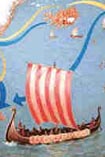 |
 |
|

Viking Iceland cradle of democracy About the Sagas living literature Vikings in America Project background Publication details Reviews Home |
Leif "The Lucky" EirikssonIn the US, October 9th has been declared Leif Eiriksson Day. In his Leif Eiriksson Day address in 1990 President George Bush urged Americans to celebrate the day by learning more about Nordic culture and history. President Clinton has also emphasised the special Nordic contribution to the rich tapestry of American culture. The settlement of Iceland was one step in the westward expansion of the Vikings. Icelanders, led by Eirik the Red, later settled in Greenland. At the turn of the millennium, on a mission to christianise the Greenlanders, Eirik's son Leif discovered the North American shores, naming the land Vinland. It was there that a new chapter in world history would be written. The Complete Sagas of Icelanders begins with the two sagas known as "the Vinland Sagas", which tell of the voyages of discovery, the attempts at colonisation, and the first encounters between Europeans and native Americans. Against this historical background a colourful cast of characters takes the stage: there is the troublemaker Eirik the Red, his brutal daughter Freydis, the pioneering explorer Leif the Lucky, and Gudrid Thorbjarnardottir, the first transatlantic woman traveller.
The steady expansion of the Viking world provided plenty of raw material for the great Icelandic Saga writers to forge into gripping, epic narrative. In the Sagas we read how the Vikings tamed new lands, not so unlike the pioneers whose legacy forms a cornerstone of American culture. Both shared an urgent need to create a new society, with new rules and a new vision of humanity. Building lives for themselves in harsh conditions at the edge of the known world, these people cultivated a distinct type of personality whose rugged exterior never quite conceals their emotional depths. The economical style of Saga narrative matches this tense and stark scenario, and influenced many American writers, including Ernest Hemingway and Dashiell Hammett, and the artistic technique of film directors such as John Ford. |

The voyages of Gudrid Thorbjarnardottir |
 © 1997 –
Leifur Eiriksson Publishing Ltd.
© 1997 –
Leifur Eiriksson Publishing Ltd.Flokagata 65 – 105 Reykjavik – Iceland Tel: (354) 552-8989 – E-mail: vinland@centrum.is |
||
